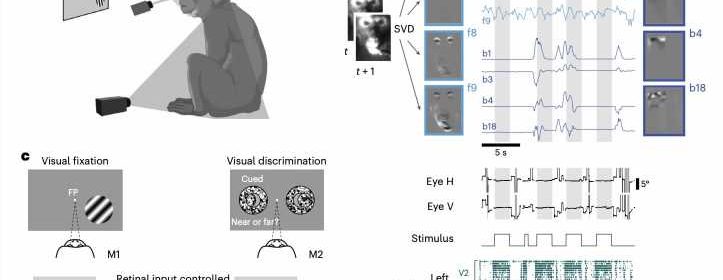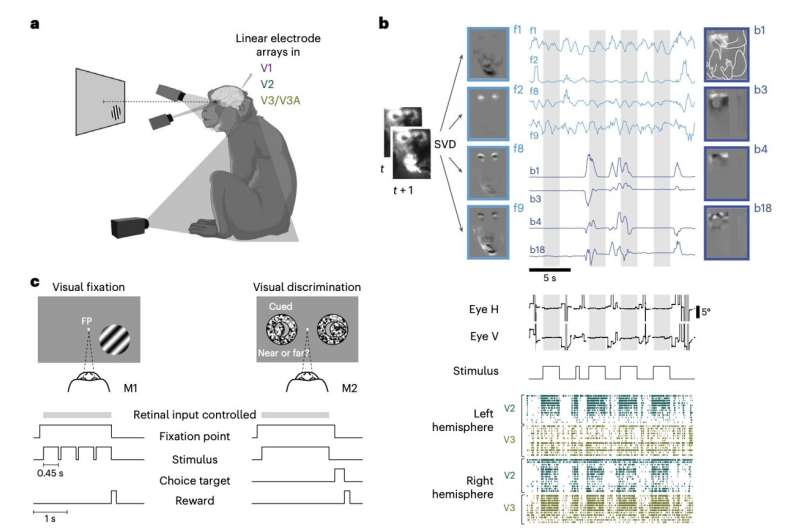Study shows that activity in the primate visual cortex is minimally linked to spontaneous movements


Many past neuroscience studies have found that animals process sensory information, such as visual stimuli, sounds, and so on, in relation to their movements within their surroundings. This experimentally confirmed idea, referred to as embodiment, has informed the present understanding of both animal and human brains, as well as the development of bio-inspired robotic systems.
Researchers at the National Institutes of Health and University of Maryland recently carried out a study on primates aimed at better understanding the neural mechanisms supporting embodiment. Their paper, published in Nature Neuroscience, showed that activity in the animals’ visual cortex is minimally linked to their spontaneous movements, yet this association could be in great part explained by impact of these movements on the images formed on the retina (i.e., the layer at the back of the eyeball).
“Organisms process sensory information in the context of their own moving bodies, an idea referred to as embodiment,” Bharath Chandra Talluri, Incheol Kang and their colleagues wrote in their paper. “This idea is important for developmental neuroscience, robotics and systems neuroscience. The mechanisms supporting embodiment are unknown, but a manifestation could be the observation in mice of brain-wide neuromodulation, including in the primary visual cortex, driven by task-irrelevant spontaneous body movements.”
Past experiments on mice had found that the brain, particularly brain regions known to support the processing of sensory information, adapted in response to the animals’ spontaneous movements. Talluri, Kang and their colleagues set out to further explore the possible link between this observed movement-related neuromodulation and embodiment.
To do this, they performed a series of experiments involving macaque monkeys (Macaca mulatta), whose visual system closely resembles that of humans. The monkeys completed a series of visual tasks, which entailed fixating their gaze on a particular spot on a display and discriminating between different visual stimuli.
While the animals completed these tasks, the researchers recorded activity in their visual cortex, brain area associated with the processing of visual information. The animals were also videorecorded, so that the team could monitor their spontaneous facial and body movements throughout the experiment.
“We sought a direct comparison using an analogous approach to those used in mouse studies,” Chandra Talluri, Kang and their colleagues wrote.
The results gathered by the researchers showed that the macaque monkeys’ spontaneous facial and body movements during the experiment accounted for very little of the variability in the neural activity recorded in their visual cortex. Nonetheless, this minimal link between movements and activity in the visual cortex was almost non-existent when the impact of eye movements was accounted for.
These results do not match those previously collected during experiments on mice, even if the team employed the same experimental methods. This suggests that there could be stark differences in the brain organization of rodents and primates.
Future studies could dive deeper into these differences, to better understand their possible relation to embodiment. Collectively, these works could shed some new light on the extent and nature of neural modulation associated with the movements performed by animals, which could in turn inform the development of more advanced bio-inspired robots.
“We found that activity in the primate visual cortex (V1, V2 and V3/V3A) was associated with the animals’ own movements, but this modulation was largely explained by the impact of the movements on the retinal image, that is, by changes in visual input,” the researchers wrote in their paper. “These results indicate that visual cortex in primates is minimally driven by spontaneous movements and may reflect species-specific sensorimotor strategies.”
More information:
Activity in primate visual cortex is minimally driven by spontaneous movements. Nature Neuroscience(2023). DOI: 10.1038/s41593-023-01459-5.
Journal information:
Nature Neuroscience
Source: Read Full Article